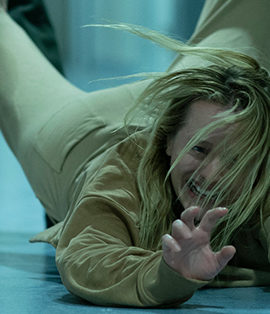Film Reviews

The Invisible Man
Genre: Thriller
Director: Leigh Whannell
Cast: Elisabeth Moss, Aldis Hodge, Storm Reid, Harriet Dyer, Oliver Jackson-Cohen
MPAA-Rating: R
Release Date: February 28th, 2020
In the tense opening moments of Leigh Whannell’s The Invisible Man, a young woman attempts to leave her abusive boyfriend. The camera captures her methodical movements as she tries to leave a beautiful home without awaking her controlling beau. There isn’t much action in the sequence but there’s a sense of growing and unmistakable dread in the atmosphere.
It’s that sense of pervasive danger and terror that makes this fresh adaptation of the H.G. Wells story so memorable.
Whannell, who wrote and directed this film, clearly understands the terror of confinement and the undeniable fear that comes along with a lack of control. In several previous films that he wrote — features like Saw and Upgrade — he focused on characters who lacked or surrendered complete control. In Saw, the main characters were handcuffed and confined in a small room. In Upgrade, the character gave some of the control of his body over to a machine inside of him. Both films worked because Whannell used those concepts to tell compelling stories.
In Whannell’s latest, Cecilia Kass — played by an ever-ready Elizabeth Moss — feels controlled by her surveillance-obsessed boyfriend Adrian (Oliver Jackson-Cohen). Early on, she escapes his elaborate home and hides at her sister’s friend’s home. But even after a few weeks of supposed freedom, Kass is still afraid to walk to the mailbox.
Adrian’s controlling nature still haunts her.
When she learns about Adrian’s death — which doesn’t make sense to her — she starts to feel that something isn’t right. Just when she starts to believe it though, Kass starts to feel a presence around her that suggests that Adrian’s death wasn’t the end of her problems.
Even with a limited budget, writer/director Whannell manages to create a growing sense of tension around the main character, who struggles to move forward in life. Instead of relying on bigger moments to capture Kass’ earned suspicions, it’s in the more intimate moments early on here that Whannell hints at the existence of an evil force surrounding her.
At times, Whannell uses his camera sparingly. He lets it rest and by doing so, he tunes the audience even deeper into the mystery. He invites the audience to look for clues suggesting the presence of an invisible man. Did that hairbrush just move? Was the heat on the stove just adjusted? By slowing things down in specific scenes here, Whannell pushes the audience to look for mysterious movements on their own.
Later on, there are a few big action sequences here where Kass and others face off against an unseen enemy and those arrive with a jolt, revealing a stark departure from earlier sequences. Although many of these scenes only show the victim (the attacker is invisible most of the time), Whannell manages to choreograph them in a way that lets the viewer’s imagination tell the rest of the story. The viewer can only guess where the unseen assailant is in these suspenseful scenes.
Although the title character attacks several people, it’s up to Moss to truly capture the trauma caused by the invisible man. For many of the fight scenes, she’s the only character onscreen and she does a spectacular job telling the story with her facial expressions and her physical performance.
For a film that this to truly work, it really needs a performer who is up for the challenge and a director who takes full advantage of the concept to tell a complete story. Both Moss and Whannell truly deliver, making this a truly memorable thriller.
Review by: John Hanlon











